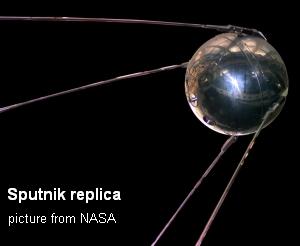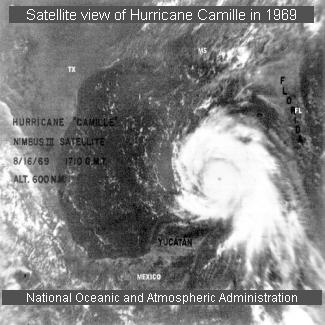SkyCaramba astronomy blog for the week ending July 16, 2011
Sometimes while we’re looking at stars, something moving off to the side catches our eyes. If you see one or two lights flashing along with it, you know right away it’s an airplane. If it makes a quick streak and disappears or leaves a grainy trail, it’s probably a meteor. The earth’s atmosphere is always sweeping up little rocks left out in space by comets, broken up asteroids, and stuff left over from the formation of the solar system. What if you’re seeing a little dot slowly making its way across the sky?
In nearly every such case, you’ve spotted a human made object orbiting the earth. There are thousands of things up there that weren’t there before people figured out how to put things in space. If you’re old enough to remember the 1940s and earlier, you once had more pristine views of the night sky. Things changed in 1957.
 The “space race” began when the Soviet Union launched Sputnik. There were only a few scientific instruments on Sputnik. The fact that an artificial satellite could be put up there shocked the world. Any doubts about whether there was a valid reason to go into space or whether it could even be done ended. The country that had invaded other countries in eastern Europe was not trusted to have benevolent purposes in the firmament. The west, specifically the United States, wanted to get into space too.
The “space race” began when the Soviet Union launched Sputnik. There were only a few scientific instruments on Sputnik. The fact that an artificial satellite could be put up there shocked the world. Any doubts about whether there was a valid reason to go into space or whether it could even be done ended. The country that had invaded other countries in eastern Europe was not trusted to have benevolent purposes in the firmament. The west, specifically the United States, wanted to get into space too.
 The next few years saw many near-Earth space travel advancements all the way up to putting men on the moon. In the realm of satellite launching, militaries learned to spy on their enemies from high above. Meteorologists got the first early warnings about hurricanes. And communications companies successfully transmitted television signals across oceans.
The next few years saw many near-Earth space travel advancements all the way up to putting men on the moon. In the realm of satellite launching, militaries learned to spy on their enemies from high above. Meteorologists got the first early warnings about hurricanes. And communications companies successfully transmitted television signals across oceans.
Since those days, thousands of things have been put in orbit around Earth. When you see a small dot crossing the sky in a matter of minutes, you’re looking at one of them. Maybe it’s taking pictures places that will be looked up on Google Earth. Maybe it’s measuring something in the upper atmosphere for scientists. Or maybe it’s a piece of space junk—something that served a purpose once but is now floating overhead almost forgotten.
The Vanguard I satellite, launched in 1958 in America’s answer to Sputnik, is the oldest piece of space junk. There are hundreds of rocket boosters up there. They were emptied putting satellites into orbit. For a few weeks in 1965, an astronaut’s glove circled the earth. Fortunately for him, it was an extra glove that he wasn’t wearing when it got away. And for several months in 2008 and 2009, a tool bag that got away from an astronaut outside the International Space Station went over head.
According to an old saying what goes up must come down. That hasn’t always been true since the space age began. Occasionally, satellites and space junk streak across the sky like meteors as they come down. The original Sputnik lasted three months.
For more information about watching artificial satellites: